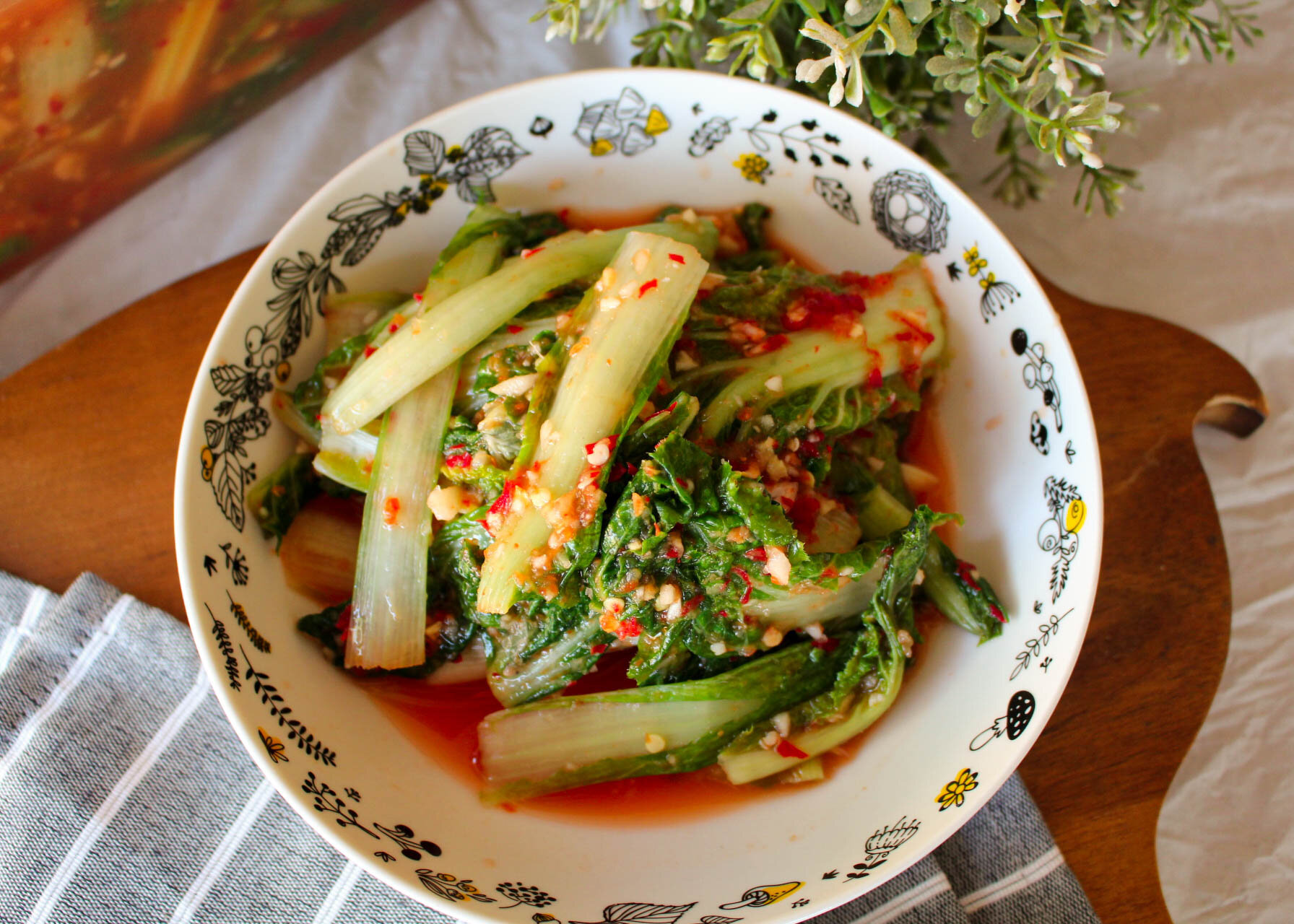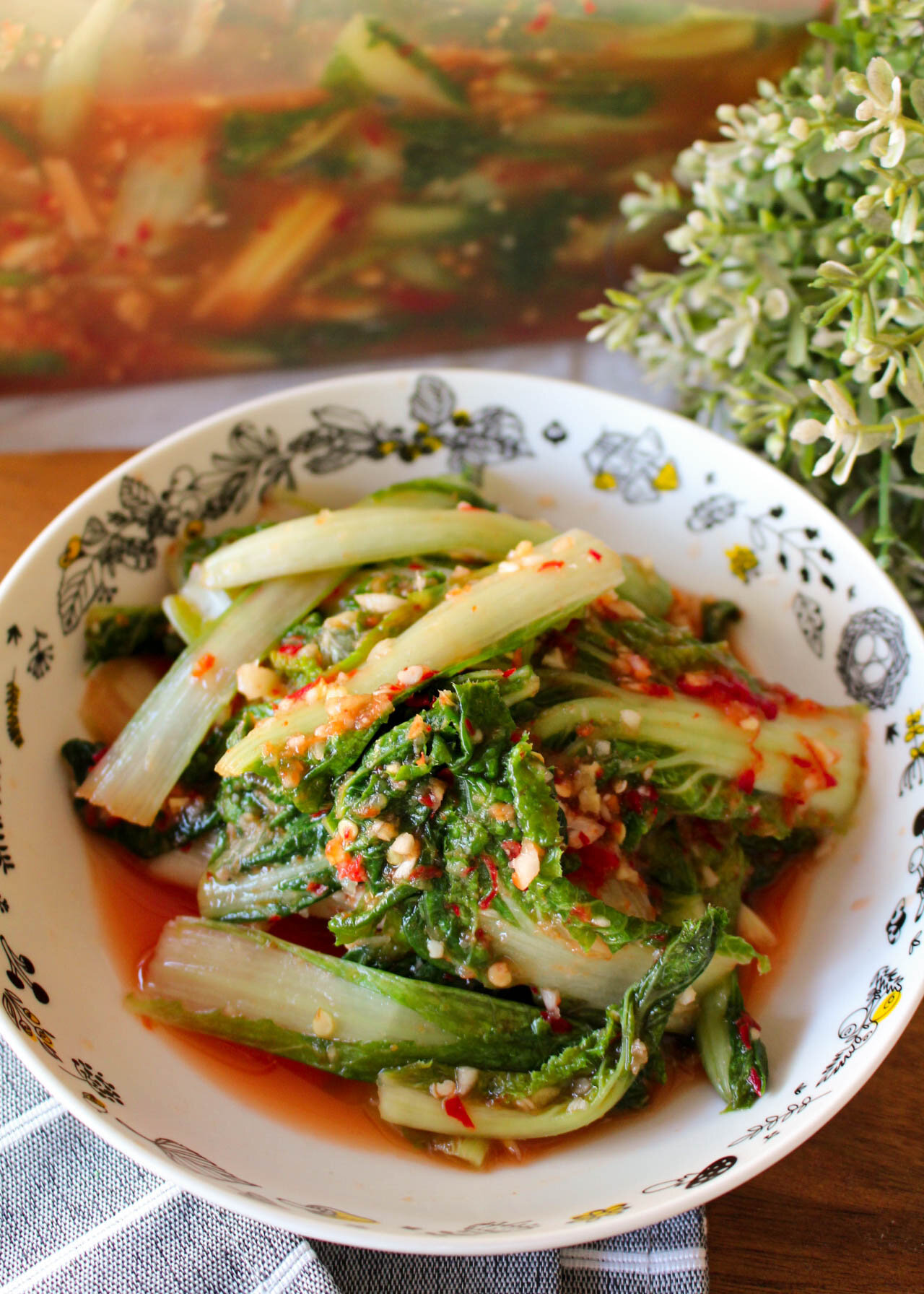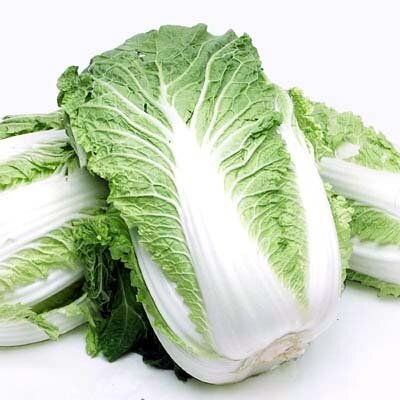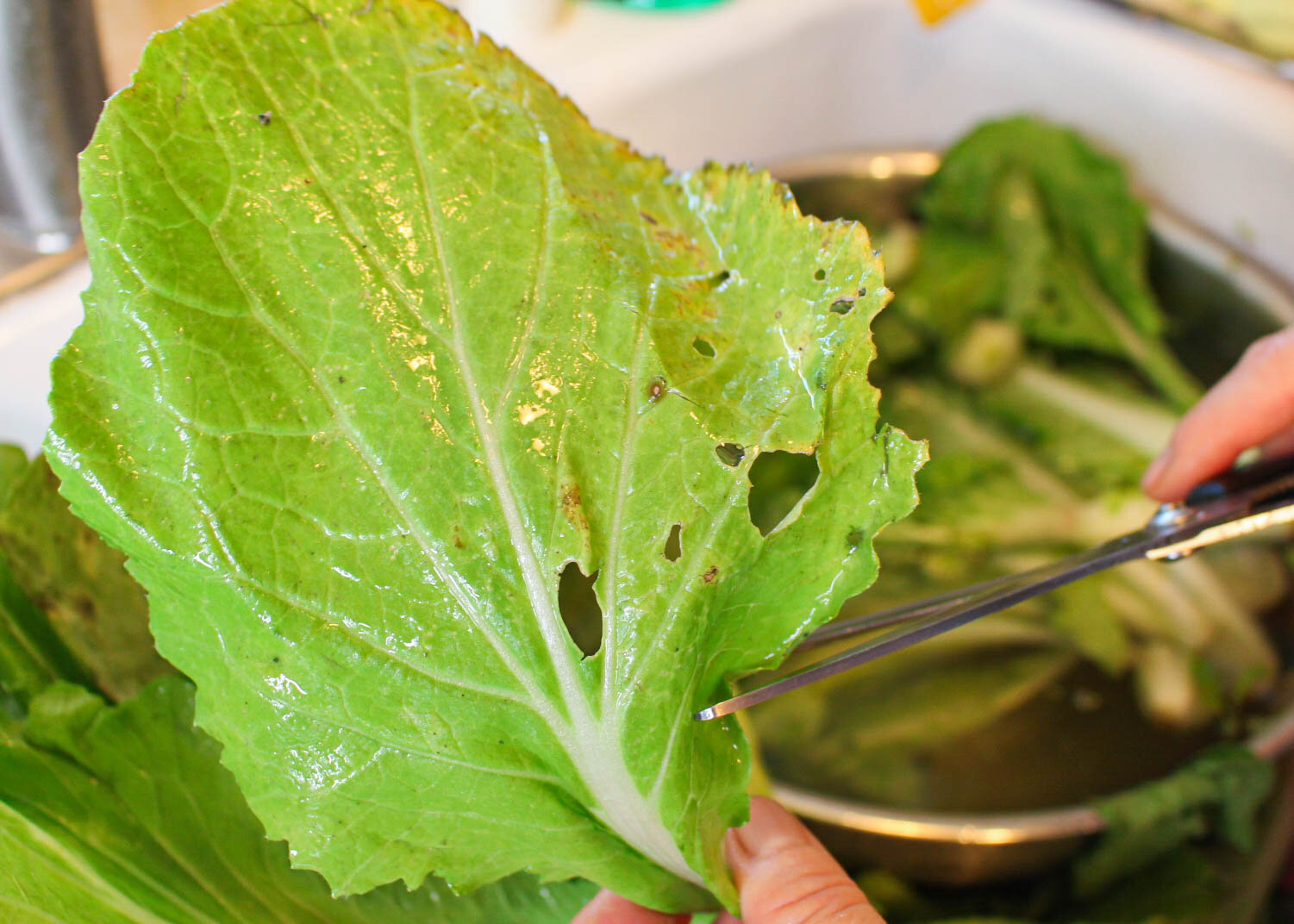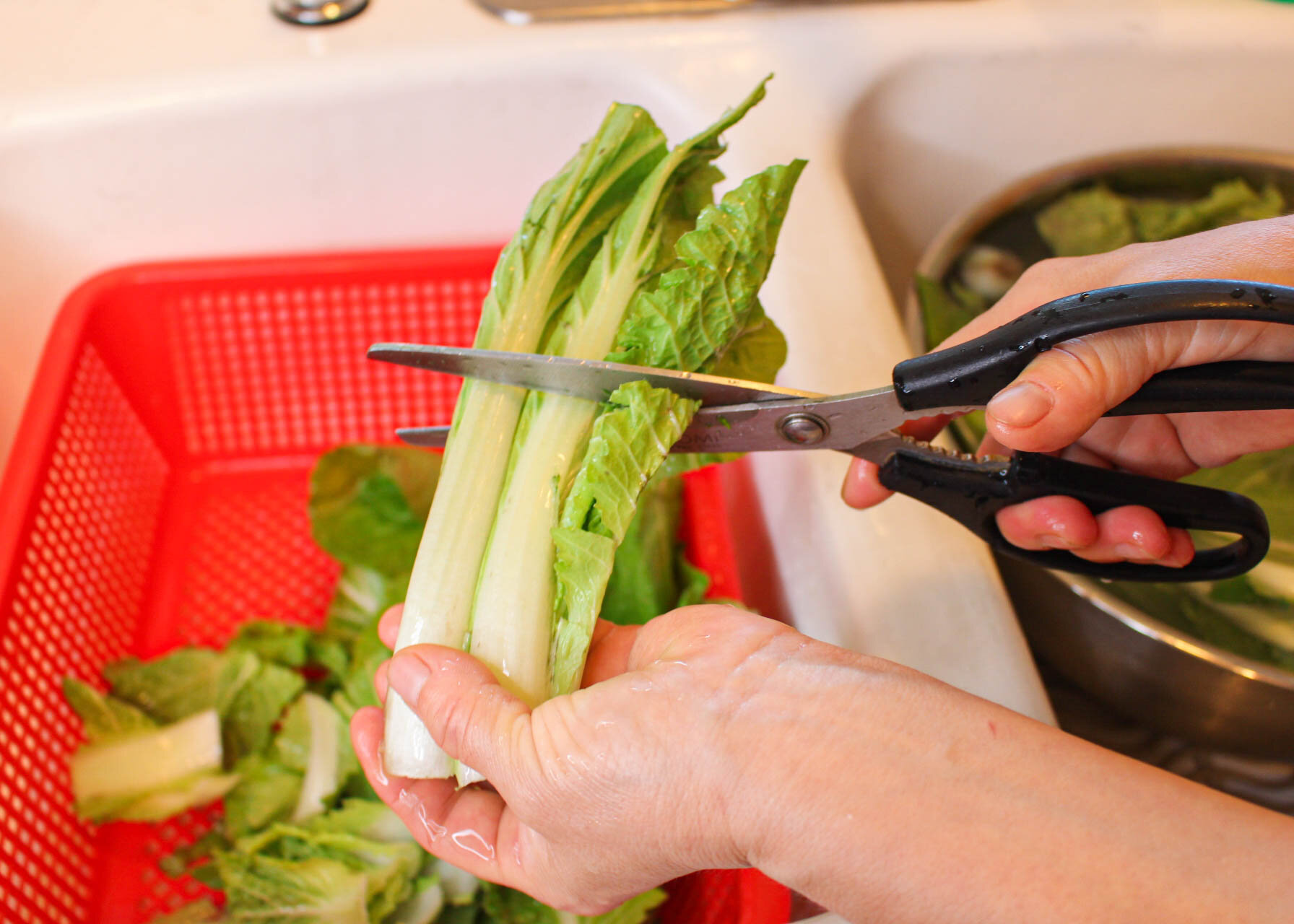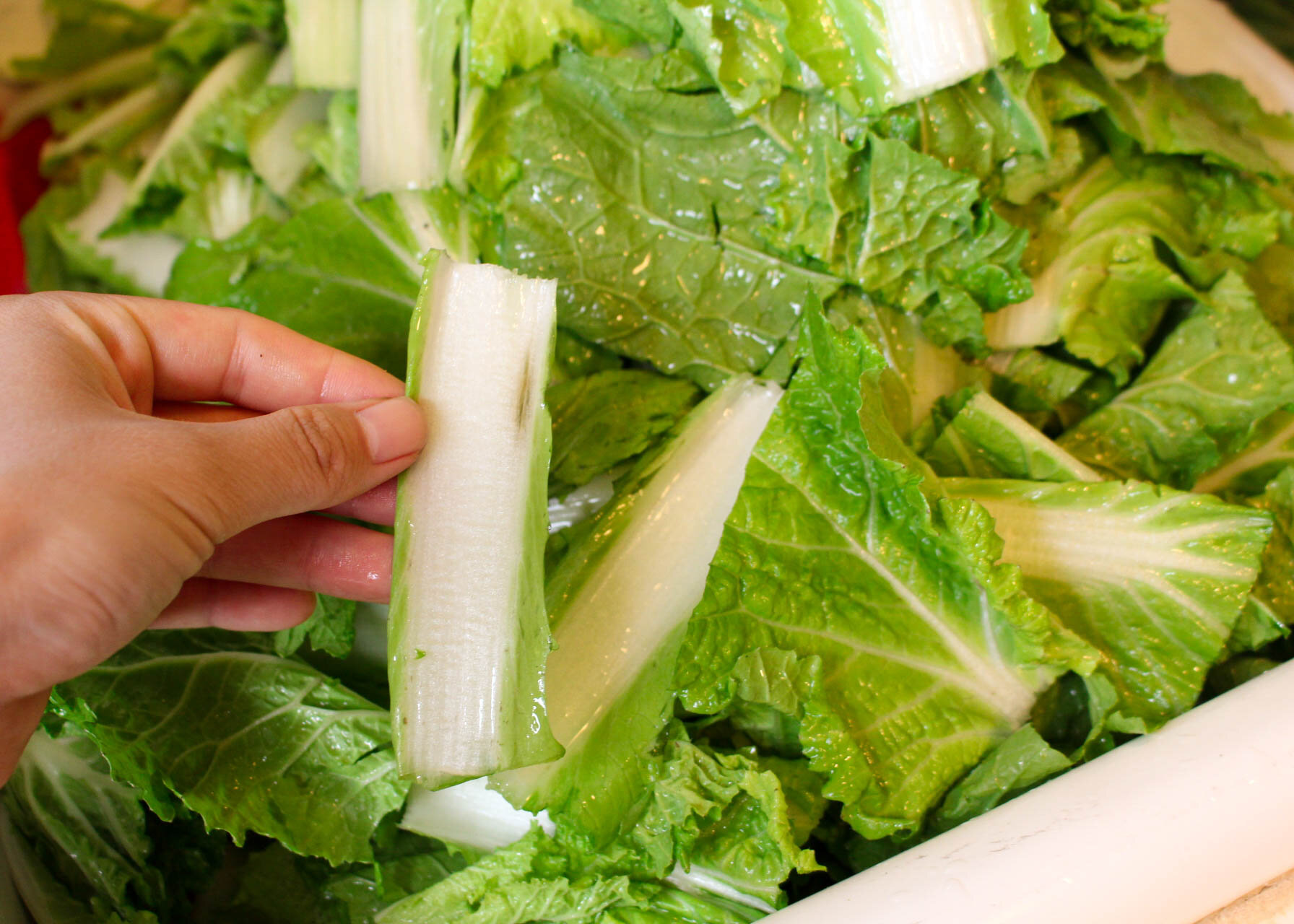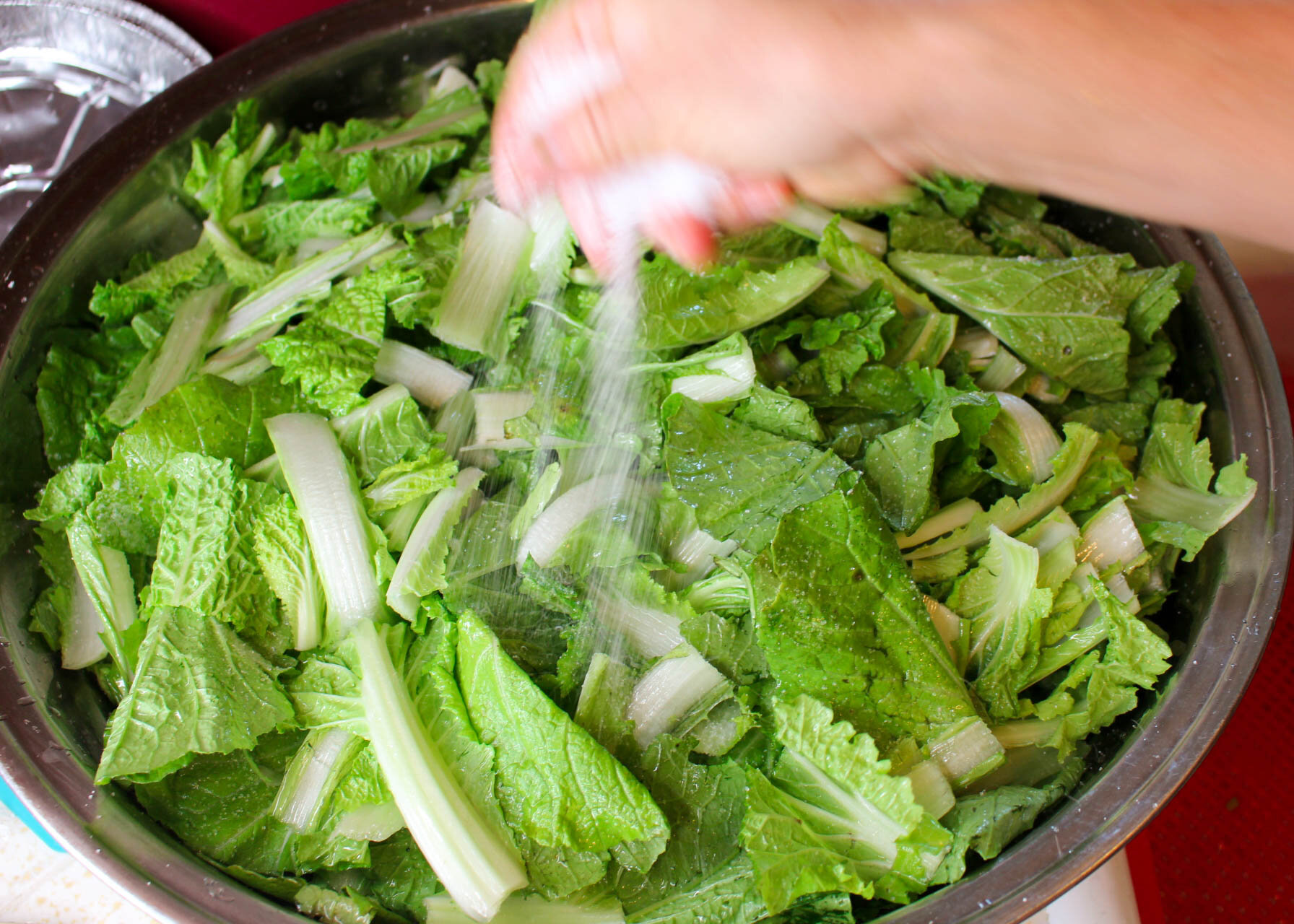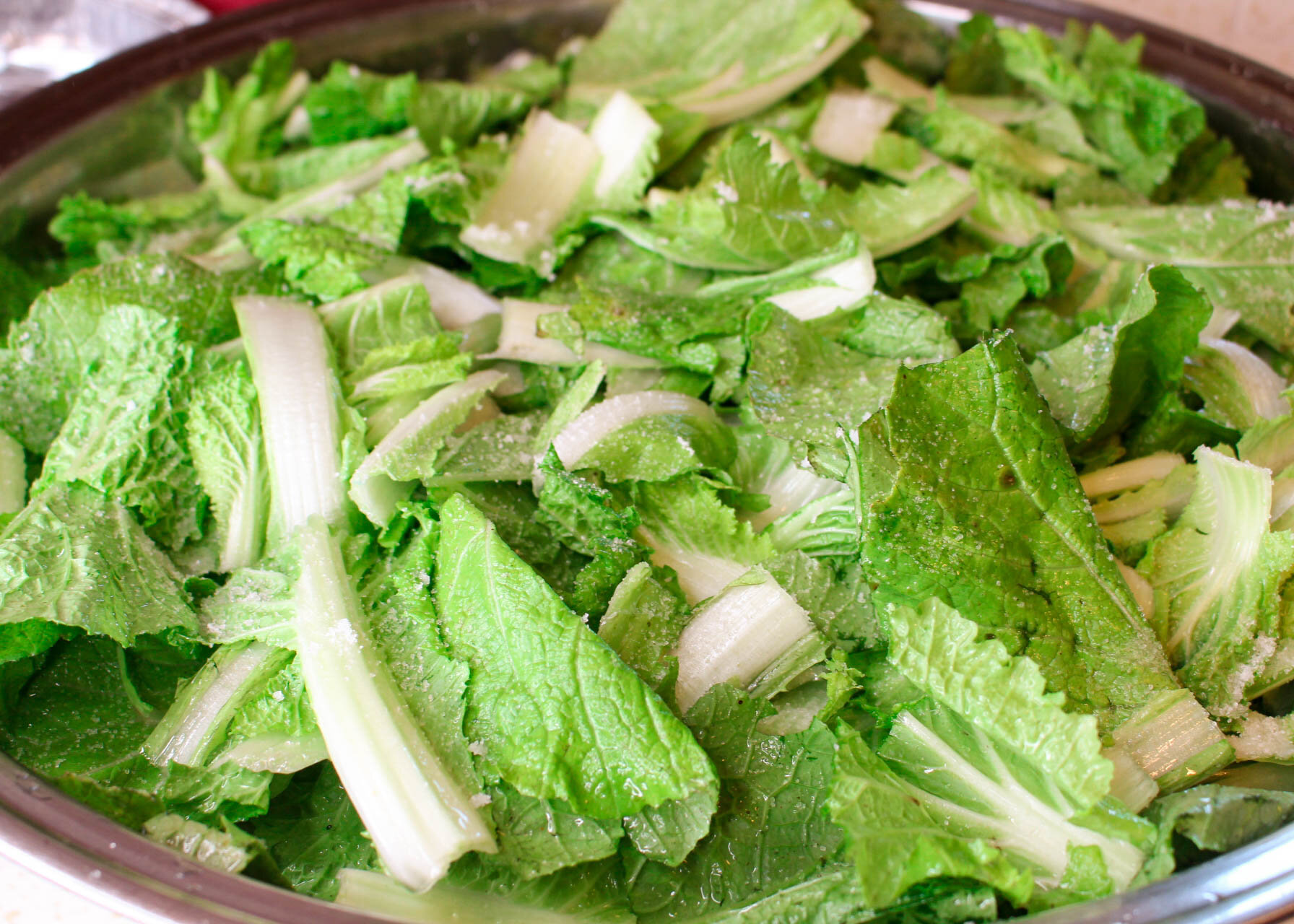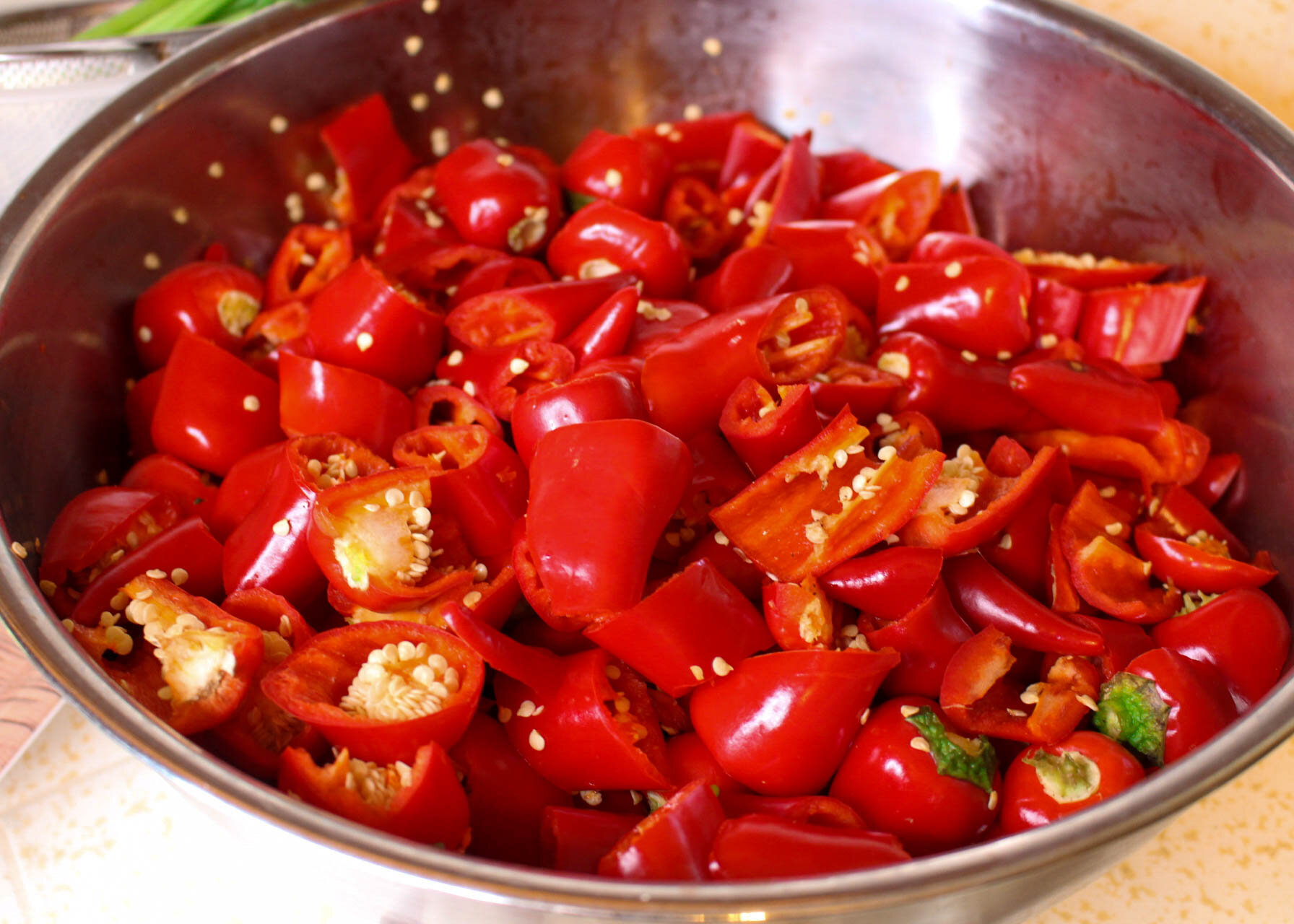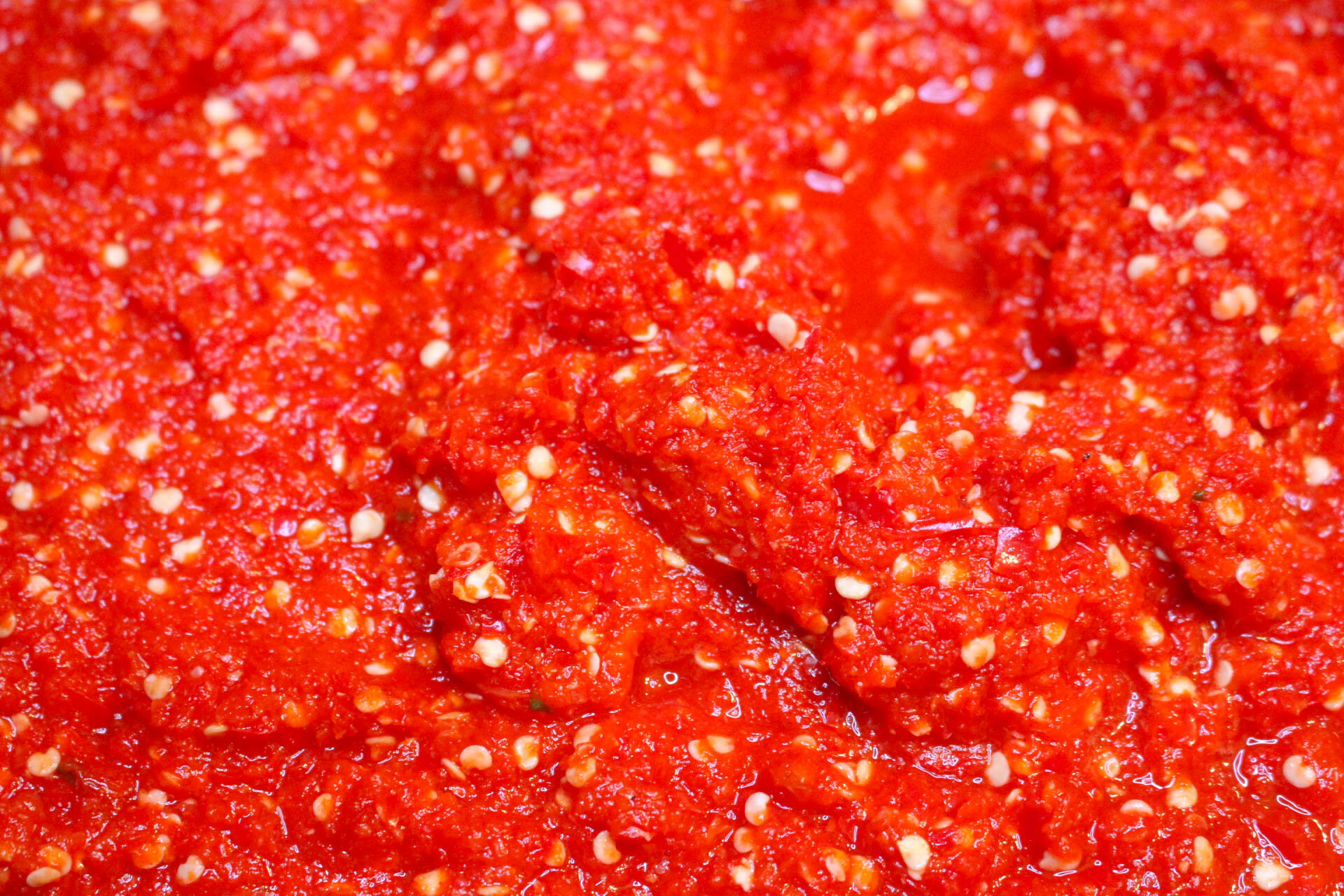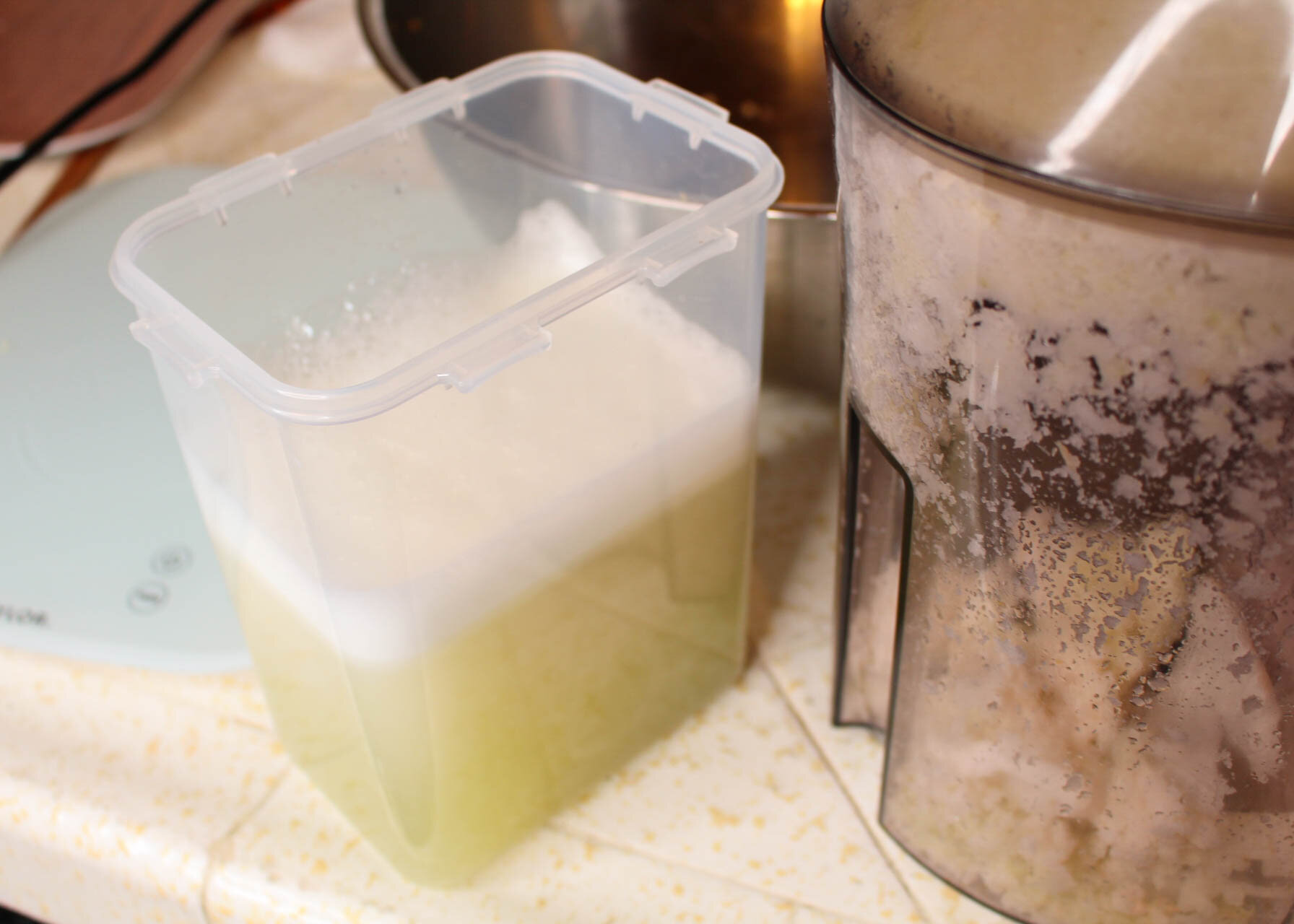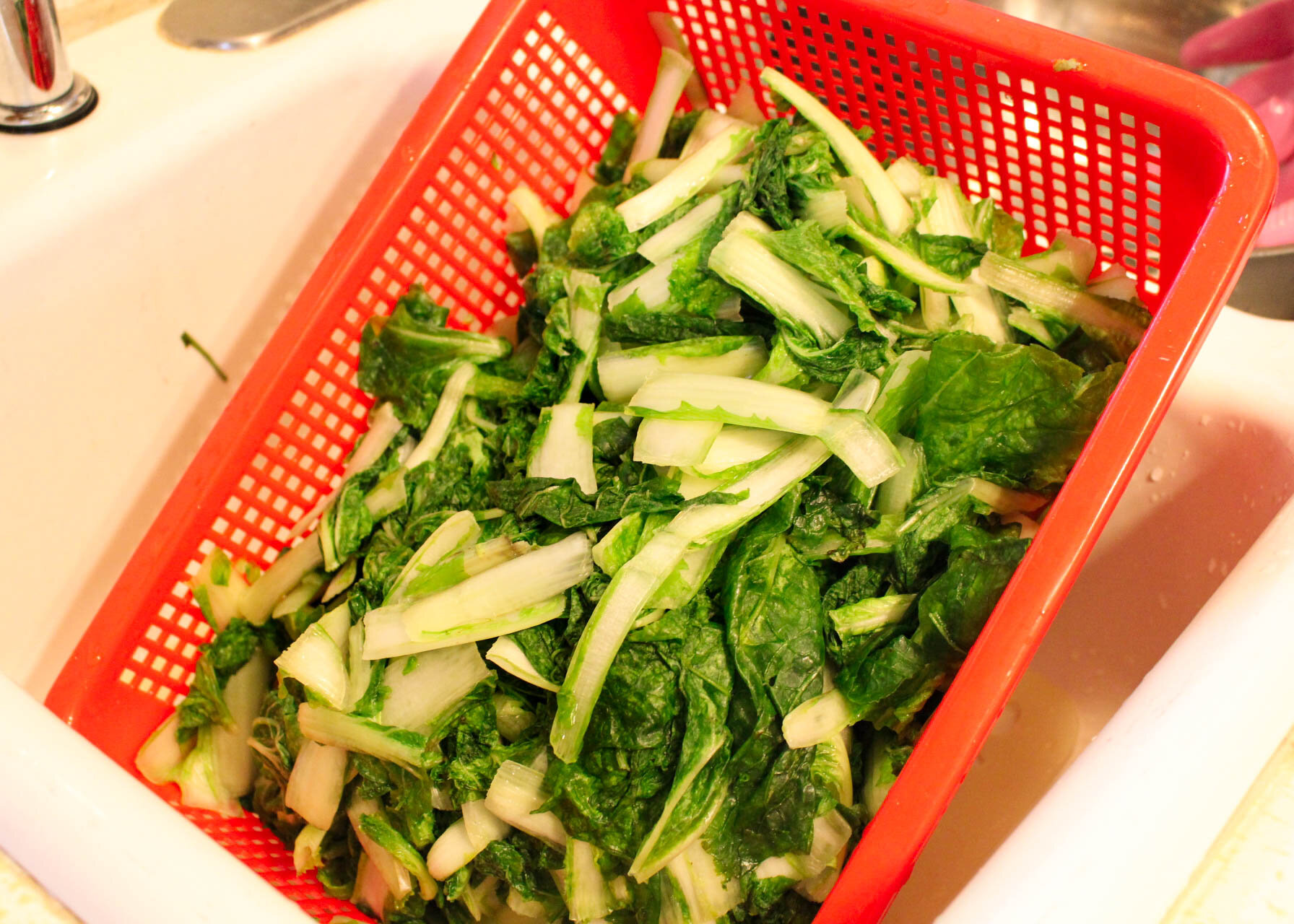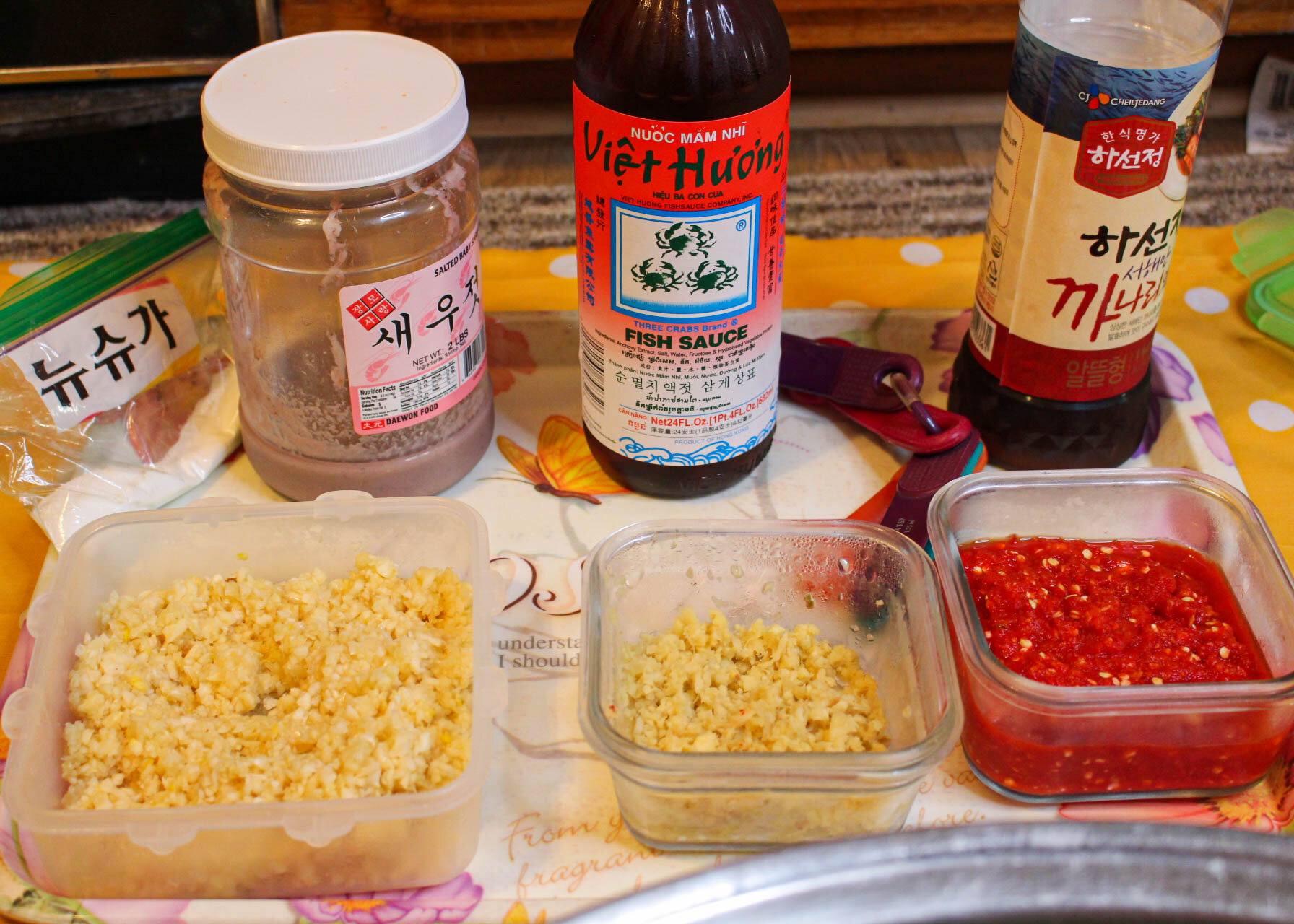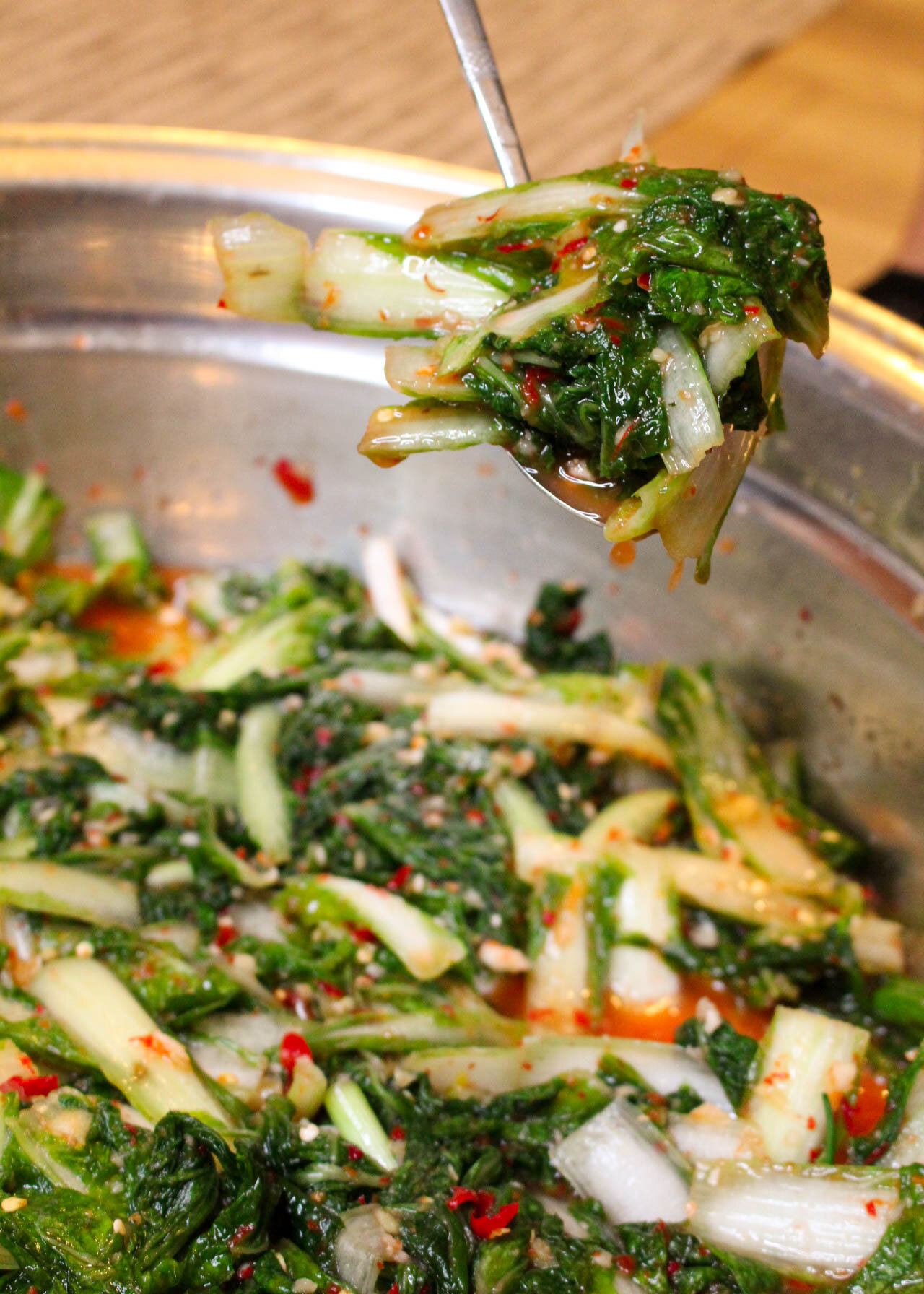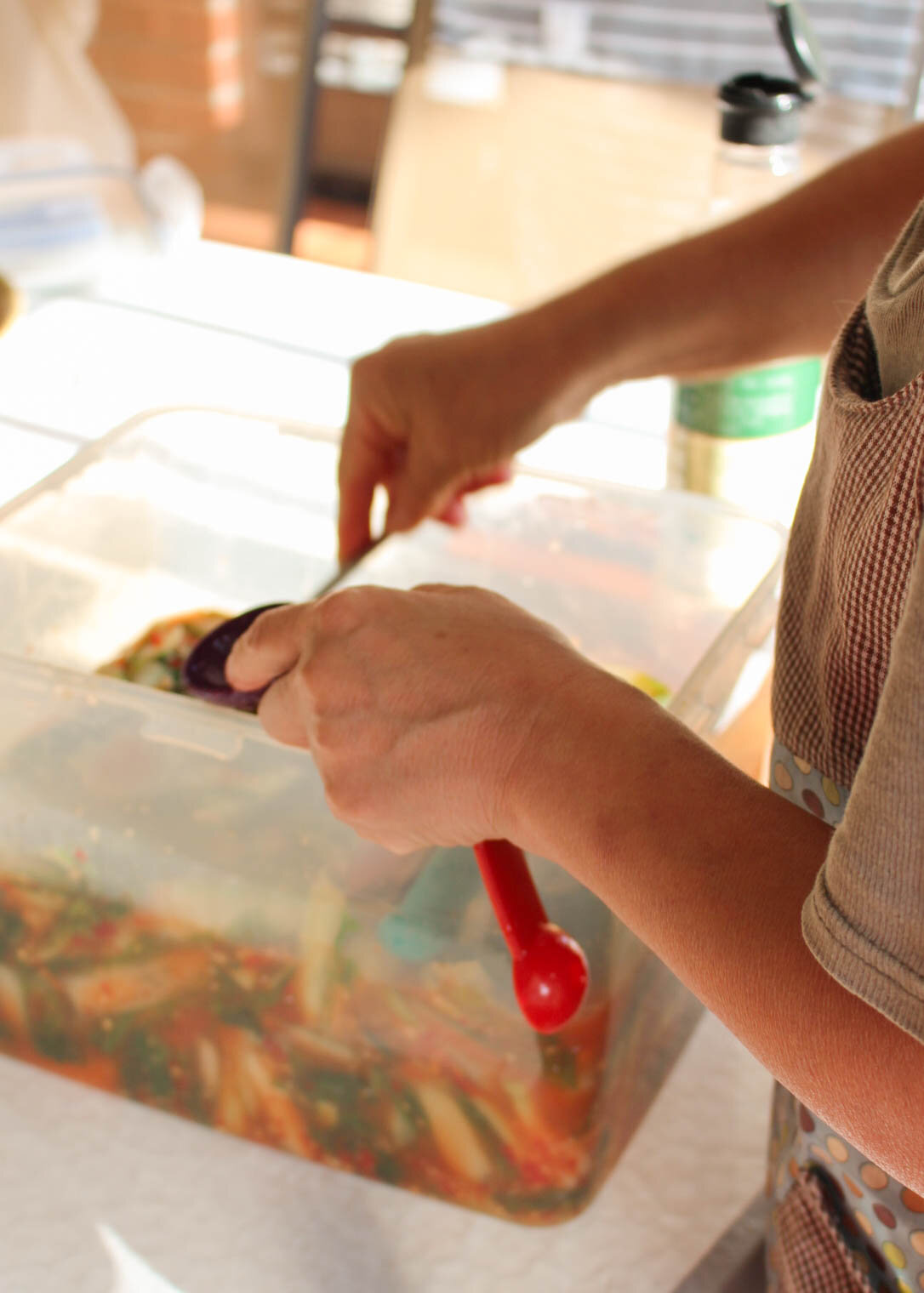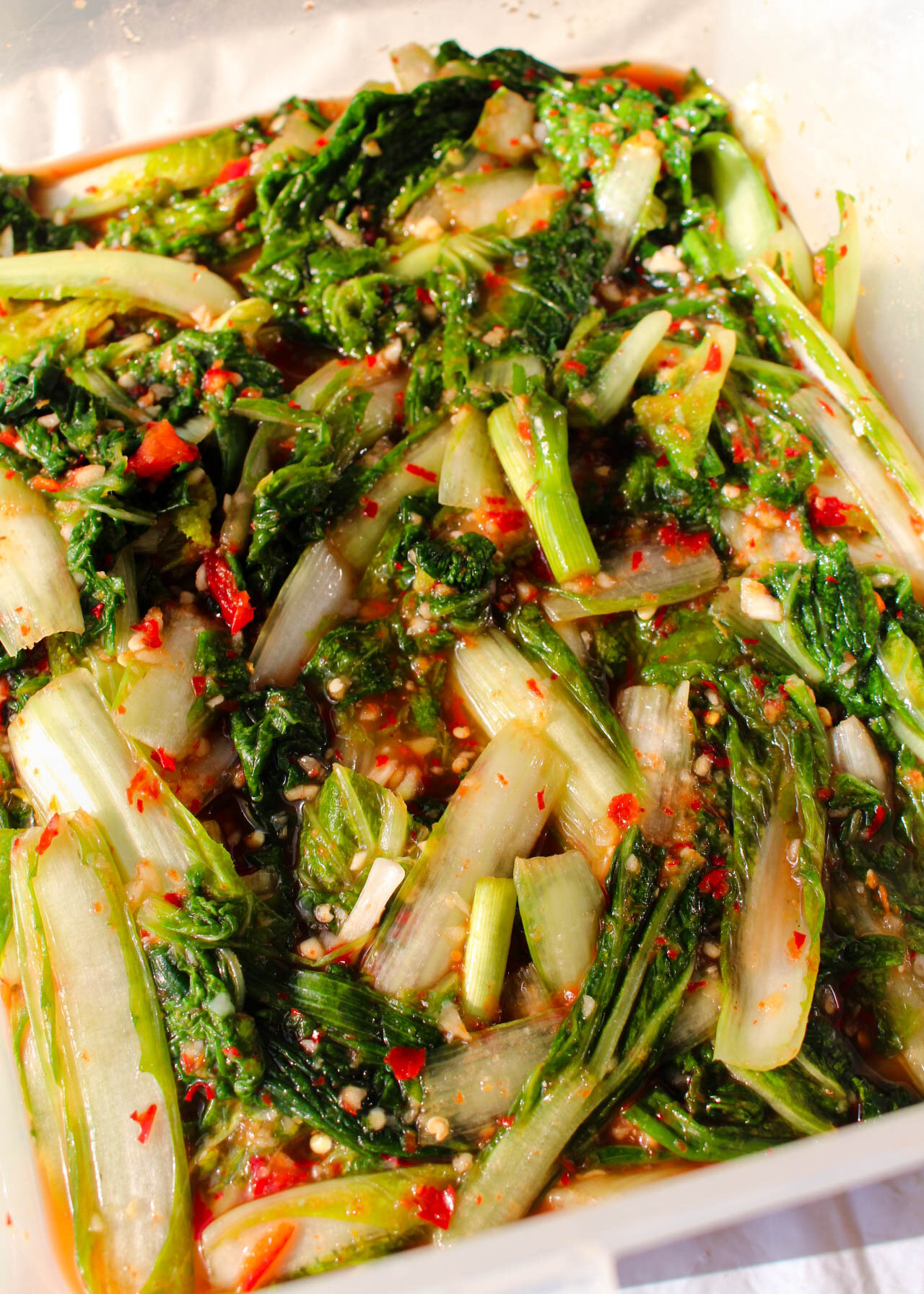Baby Napa Cabbage Kimchi (Putbaechu) | 풋배추
pronounced: poot baeh-chu
What: Baby Napa Cabbage Kimchi | Putbaechu Kimchi. This is kimchi made from baby napa cabbage (instead of regular napa cabbage). It’s a very fresh kimchi eaten commonly by Koreans in the summer and hotter months.
Taste: Baby napa cabbage kimchi is very similar to regular napa kimchi but it’s more crisp, fresh, and juicy. It’s the perfect kimchi for summer; a taste we all naturally gravitate towards when it gets warm.
As with any kimchi— It’s a fermented dish. It’s sour, somewhat spicy, umami, and tangy. The flavor will change as it ferments more.
How It’s Made: Coat baby napa cabbage in water, chop, then salt. Let it soak up all the salt. Meanwhile, prepare kimchi seasoning. Add kimchi seasoning to salted cabbage and mix well. Pack it in airtight container. Let it ferment and enjoy it.
What to Serve it With: So many things. First, don’t eat it by itself. No Koreans do that. Eat with rice. Eat it with eggs. Eat with steak and mashed potatoes. Make Kimchi Fried Rice, Kimchi Stew, Kimchi Pancakes. Hell, I like to eat with Mac & Cheese. It’s unbelievably good with so many things. It gives you that umami kick.
Notes & Tips: This is a very special recipe that my Mom uses. No substitutions if you want her authentic kimchi. All ingredients can be found in a Korean Grocery Market. This is her exact recipe for a family of 4, so if you want to half it, please do so!
*You can find all ingredients at the Korean Grocery Market. Please refer to photos below in the instructions to see exact products we used.
*If you do not have a juicer for juice the daikon radish & onion, then you do not need to buy daikon radish. Simply blend onions in a blender with water (detailed in instructions).
*New Sugar (spelt out as 뉴슈가) is sweeter than white sugar and has different components. This is a recipe secret my Grandma passed down to my Mother.
Ingredients

Baby Napa Cabbage Kimchi (Putbaechu) | 풋배추
Ingredients:
- 8 lbs baby napa cabbage (should look healthy, medium size, green, etc. see picture below)
- A little over 3/4 cup granulated plain salt (226g)
- 2 cups water
- 2 Tbsp flour (any kind is fine, we used All Purpose Flour)
- 15 red chili peppers (red jalapeños) (300g)
- 1 medium daikon radish (optional, esp. if you do not have a juicer)*
- 1 large brown onion
- 7 green onions
- 4 heaping Tbsp garlic, minced (126g)
- 2 Tbsp ginger, minced (38g)
- 1 Tbsp Korean plum extract (We use CJ brand)
- 4 Tbsp Three Crab Fish Sauce
- 3 Tbsp Korean Fish Sauce for Kimchi (We use CJ brand)
- 4 Tbsp salted baby shrimp (73g), be sure to mix baby shrimp in its container with liquids before scooping up a tablespoon
- 1/2 tsp + heaping 1/4 tsp Korean New Sugar (click to see picture, product located bottom in picture)*
- Water
Notes:
instructions
Flour Mixture
We are going to make this flour mixture that will help preserve the fermentation of the kimchi. We are doing this first because it needs time to cool completely.
Do not turn on the stove heat just yet. In a small pot, add in 2 cups of water and 2 Tbsp of flour. Whisk ingredients so they are well incorporated. Turn ON the heat to medium-high, and begin mixing this until it creates very slow bubbles (2-3 minutes). Once bubbles form: reduce heat to medium, mix for 1 minute, and turn off heat. The consistency should be thin and watery (but thicker than how it was before it heated). It should drip off your mixing utensil quick. Turn off the heat immediately and move it away from that heat. It needs to cool completely. Set aside.
Wet & Chop Cabbage
In your sink, submerge all cabbage in cold water. This is so the salt sticks to the cabbage. We are NOT washing the cabbage (we will do that later); think of it as coating the cabbage with water. Cut off the bottom stem, and chop off any bad parts of the cabbage (yellow and black brown spots on leaves). Use scissors to cut cabbage so you have leaf pieces (not the crunchy part—loose leaf on top of rib) and the rib pieces (crunchy part of cabbage), seen below. Rib pieces should be about 2 to 2.5 inches. It’s okay if leaf pieces are big— they will shrink. Place chopped cabbage in a strainer.
Layer & Salt Cabbage
The type of salt you use in Kimchi matters. My Mom used a little over 3/4 cup (226g) of Granulated Plain Salt. You can find this in any grocery market. We buy it in bulk from Costco.
In an extra large bowl, place a layer of the chopped cabbage and toss in generous amounts of salt so that each chopped cabbage is coated in salt. Repeat until all cabbage and salt is used. Gently press down on the cabbage so it’s nicely packed.
Cover Cabbage & Wait
Cover the cabbage bowl. My mom just used a large strainer.
Let it sit for about 1 hour ONLY to prune up a bit (it won’t prune like raisins, but it will get a bit smaller). Do NOT let it sit for longer. Toss it around halfway through so that the bottom cabbages are on top, and the top cabbages are on bottom. Gently press down again. Let it prune up for the remaining 30 minutes.
Flip 30 minutes in, cover, and let it sit for 30 more minutes.
Prepare Kimchi Ingredients
While chopped cabbage is doing it’s thing (above) for 1 hour, prepare all the ingredients that will flavor up this cabbage into kimchi.
Blend Red Chili Peppers
Blend 15 red chili peppers (chopped into smaller pieces) in a blender. STOP blending once all red peppers are JUST blended up— you still want texture to it. We will need 1.5 cups (300g) of this. Measure that out and set aside.
Be careful! Do NOT touch your face after blending these. These red chili peppers are hot, and if you touch your eyes, they will burn. Likewise with nose, mouth, etc.
Tip: If you have extra blended red chili peppers, just freeze it and use it for other recipes!
Juice (or alternatives) Daikon Radish and Onion
In a juicer, add in 1 large brown onion (chopped into smaller piece) and 1 medium daikon radish (chopped into smaller pieces). Once both the onion and radish are juiced, stir it, and set aside. Measurements do not matter for this. We are going to use all that juice.
If you do not have a juicer:
Blend 1 large brown onion (chopped into smaller pieces) with as much water you need in a food processor or blender. Blend as far as you can to resemble a juice consistency.
Since you do not have a juicer, you will not use daikon radish (it won’t blend in the food processor or blender)— no worries. We will substitute with using water instead of daikon juice later.
Chop 7 Green Onions
Chop off the very bottom roots and discard. Chop green onions into 1.5 inch pieces. For the bottom part (hard, white stem part) of the green onions, slice into halves so we don’t have thick pieces of green onions.
Doesn’t have to be exactly 7 green onions by the way. My Mom just happened to use 7.
Wash Cabbage
After 1 hour: the chopped cabbage has soaked in the salt and should have pruned a bit. We now need to wash and rinse it.
In your sink, submerge chopped cabbage in COLD water. Gently toss it around to rinse out any dirt. Do this several times until all dirt is gone (My Mom washed it about 5 times— these baby napa cabbages easily collect dirt!)
Place cabbage in a strainer, and let the excess water drain for 15 min.
Tip: Slant up the strainer to drain water.
Make Kimchi
In a very large bowl, add in all the ingredients and gently mix with hands (wear gloves).
Chopped cabbage, drained
1½ cup red chili peppers, blended (300g)
Green onion, chopped
Flour mixture
4 heaping Tbsp garlic, minced (126g)
2 Tbsp ginger, minced (38g)
1 Tbsp Korean plum extract (We use CJ brand)
4 Tbsp Three Crab Fish Sauce
3 Tbsp Korean Fish Sauce for Kimchi (We use CJ brand)
4 Tbsp salted baby shrimp (73g), be sure to mix baby shrimp in its container with liquids before scooping up a tablespoon
1/4 tsp + 1/8 tsp Korean New Sugar*
Mix. Once incorporated, level out the chopped cabbage so it’s even in the large bowl. Add in entire daikon and onion juice (OR blended onion); it should not exceed the height of the cabbages—you should be able to pour the entire thing in. This is to dilute some of the spiciness from the red chili peppers.
You will notice that there is liquid beneath the cabbage (if the liquid is at the same level, no need to move onto next step). Add in water (start small, 1 cup at a time) until the liquid is just below the cabbage. We personally needed to add 2 cups of water.
Mix again until well incorporated.
Store in Airtight Container
Store kimchi in an airtight container. We store kimchi in Lock & Lock containers. You can use Mason jars. Any airtight container will do.
Set aside in a cool place (indoors) overnight (12 hours). My Mom just set it aside in our dining room underneath a desk.
Refrigerate Kimchi & Enjoy It (later)
The next day: After 12 hours, it’s time to refrigerate.
Refrigerate and taste kimchi that’s at the bottom every few days. Toss around the liquids so that the top gets covered with liquid again.
The taste will change as it slowly ferments. Enjoy it when it tastes perfect for you. We eat fresh kimchi (barely fermented) and very fermented kimchi depending on our moods and the dishes we are having; we eat it at every stage. We typically finish this baby napa kimchi within 2-3 weeks (it ferments faster in summer).
Fermentation time varies on how much salt was used and season. It’s key to taste as it ferments. Your kimchi should taste tangy and slightly sour, and even more so when it’s very fermented.
Some other pointers:
Kimchi should be always refrigerated.
Kimchi ferments faster in warmer seasons, so keep this in mind if you are making this especially during summer. It will ferment much faster!
It will last a long time. It’s a fermented food! Our kimchi can last up 3 months especially in the colder seasons. That’s when you make some kimchi fried rice, stew, pancakes, etc.
